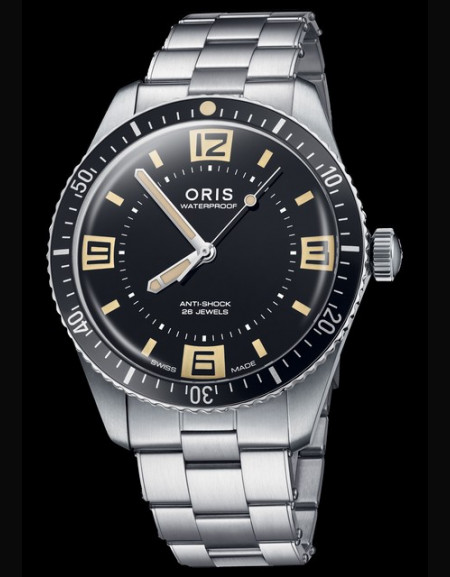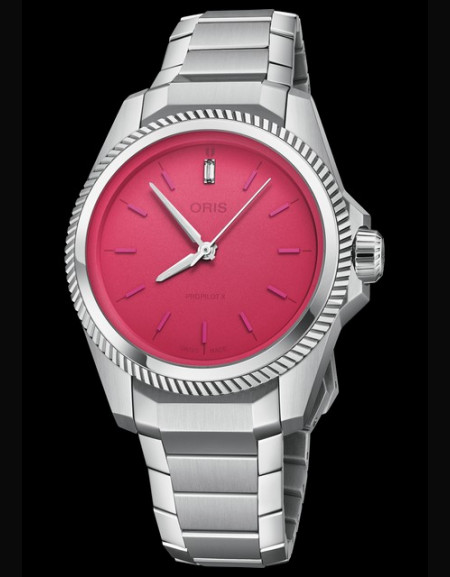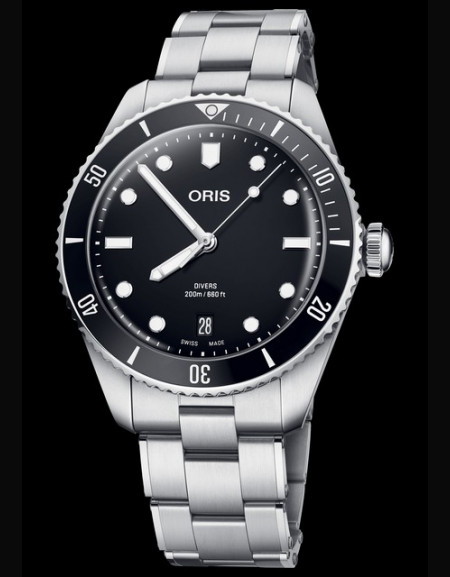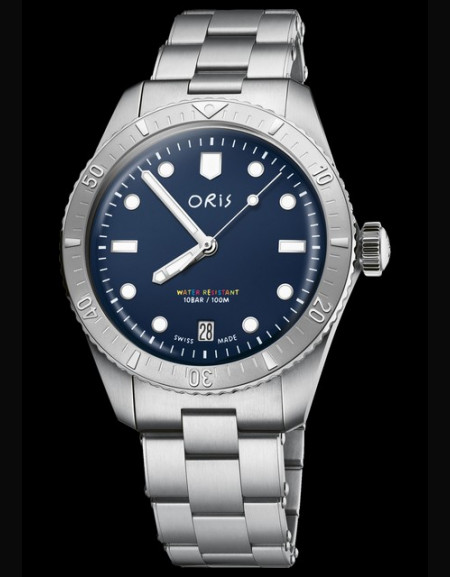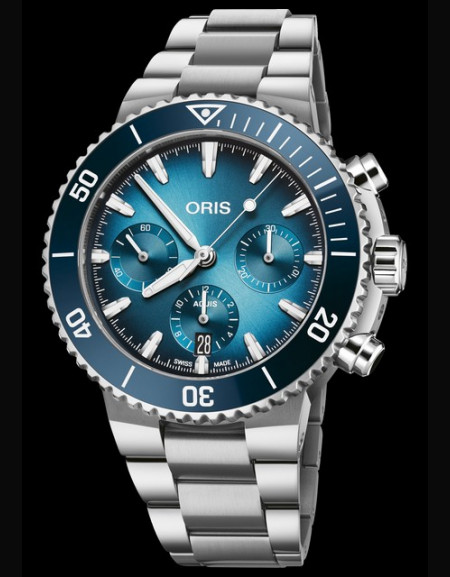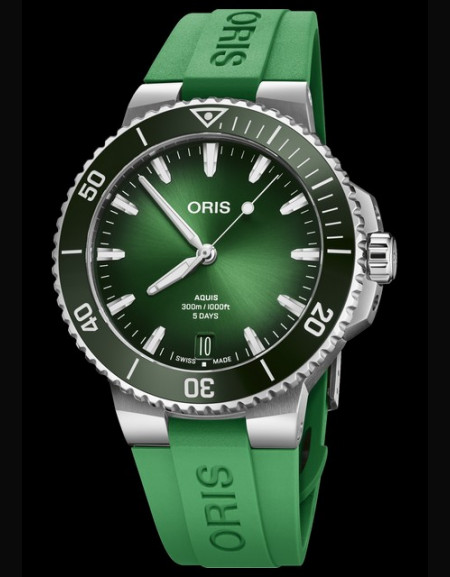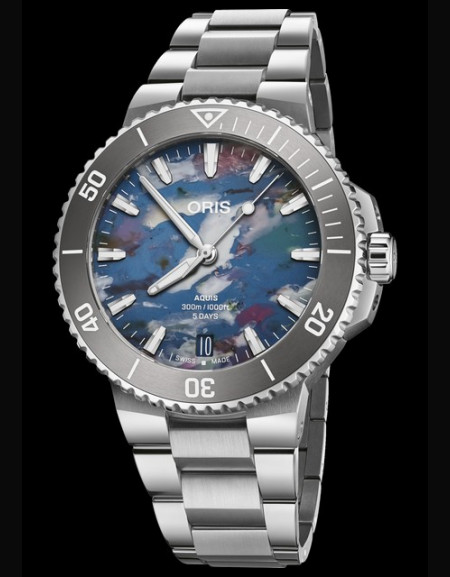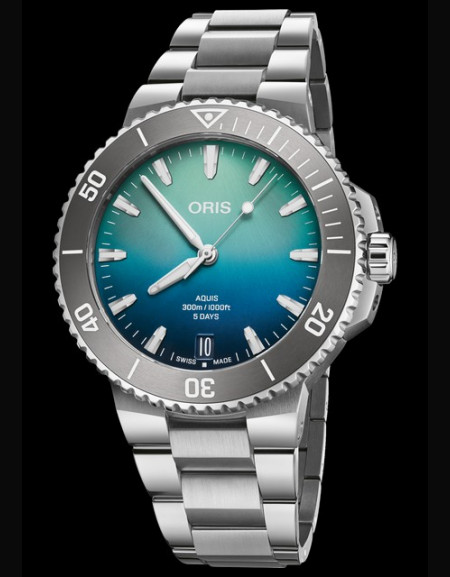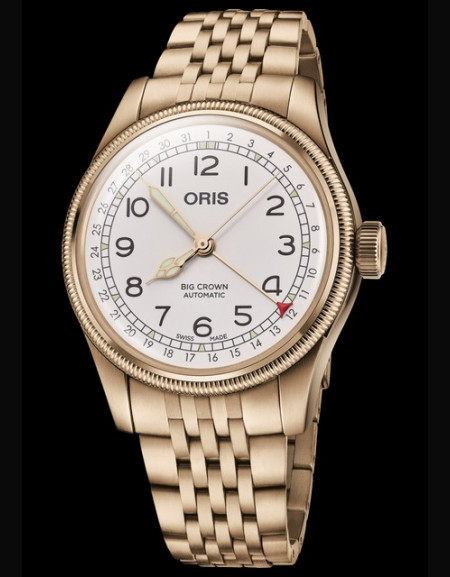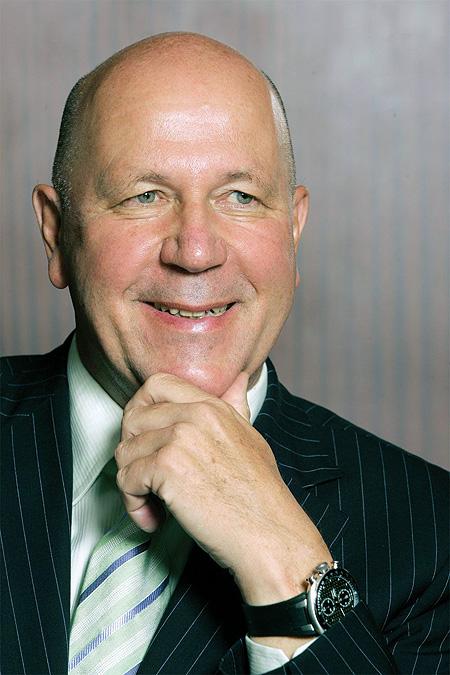
|
||
Oris history
Both come from the watch making capital Le Locle in the Swiss Jurassic region. Starting with just 24 workmen, they take over the recently closed down watch firm Lohner & Co.
Oris is the name of a brook and a valley close to Hölstein in the north-western part of Switzerland.
1906 : In 1906 the first of ten branches in Switzerland is opened.
1911 : In 1911, Oris employs over 300 people at Hölstein, building houses and flats for them and soon...

THE COLLECTIONS

-
Divers Sixty Five 60th...
SEE THE DATA SHEETBrand: Oris
Collection: Divers
Ref: 01 733 7772 4034-Set
Price: 2 250 € -
ProPilot X Miss Piggy...
SEE THE DATA SHEETBrand: Oris
Collection: ProPilot
Ref: 01 531 7796 4158-07 8 17...
Price: 2 800 € -
Divers Date
SEE THE DATA SHEETBrand: Oris
Collection: Oris Divers
Ref: 733 7795 4051-Set
Price: 2 450 € -
Divers Date
SEE THE DATA SHEETBrand: Oris
Collection: Oris Divers
Ref: 733 7795 4055-Set
Price: 2 450 € -
Divers Date
SEE THE DATA SHEETBrand: Oris
Collection: Oris Divers
Ref: 733 7795 4054-Set
Price: 2 450 € -
LFP Limited Edition
SEE THE DATA SHEETBrand: Oris
Collection: Oris Divers
Ref: 733 7771 4085-Set
Price: 2 500 € -
Aquis Chronograph 43,50mm
SEE THE DATA SHEETBrand: Oris
Collection: Oris Aquis
Ref: 01 771 7793 4155-07 8 23...
Price: 4 400 € -
Divers Sixty-Five Date 40 mm
SEE THE DATA SHEETBrand: Oris
Collection: Oris Divers
Ref: 01 733 7707 4057-07 8 20 18
Price: 2 450 € -
Divers Sixty-Five Calibre...
SEE THE DATA SHEETBrand: Oris
Collection: Oris Aquis
Ref: 01 400 7774 4057-07 8 19 18
Price: 3 600 € -
Aquis Date Taste of Summer
SEE THE DATA SHEETBrand: Oris
Collection: Oris Aquis
Ref: 01 733 7787 4138-07 8 22...
Price: 2 400 € -
Aquis Date Taste of Summer
SEE THE DATA SHEETBrand: Oris
Collection: Oris Aquis
Ref: 01 733 7787 4137-07 8 22...
Price: 2 400 € -
Aquis Date 43,5mm
SEE THE DATA SHEETBrand: Oris
Collection: Oris Aquis
Ref: 01 733 7789 4150-07 8 23...
Price: 2 450 € -
Aquis Date 43,5mm
SEE THE DATA SHEETBrand: Oris
Collection: Oris Aquis
Ref: 01 733 7789 4135-07 4 23...
Price: 2 200 € -
Aquis Date 43,5mm
SEE THE DATA SHEETBrand: Oris
Collection: Oris Aquis
Ref: 01 733 7789 4157-07 4 23...
Price: 2 200 € -
Aquis Date 43,5mm
SEE THE DATA SHEETBrand: Oris
Collection: Oris Aquis
Ref: 01 733 7789 4154-07 8 23...
Price: 2 400 € -
Aquis Date 43,5mm
SEE THE DATA SHEETBrand: Oris
Collection: Oris Aquis
Ref: 01 733 7789 4135-07 8 23...
Price: 2 400 € -
Aquis Date 43,5mm
SEE THE DATA SHEETBrand: Oris
Collection: Oris Aquis
Ref: 01 733 7789 4157-07 8 23...
Price: 2 400 € -
Aquis Date Calibre 400...
SEE THE DATA SHEETBrand: Oris
Collection: Oris Aquis
Ref: 01 400 7790 4150-07 8 23...
Price: 3 750 € -
Aquis Date Calibre 400
SEE THE DATA SHEETBrand: Oris
Collection: Oris Aquis
Ref: 01 400 7790 4135-07 4 23...
Price: 3 600 € -
Aquis Date Calibre 400
SEE THE DATA SHEETBrand: Oris
Collection: Oris Aquis
Ref: 01 400 7790 4157-07 4 23...
Price: 3 600 € -
Aquis Date Calibre 400
SEE THE DATA SHEETBrand: Oris
Collection: Oris Aquis
Ref: 01 400 7790 4135-07 8 23...
Price: 3 700 € -
Aquis Date Calibre 400
SEE THE DATA SHEETBrand: Oris
Collection: Oris Aquis
Ref: 01 400 7790 4157-07 8 23...
Price: 3 700 € -
Great Barrier Reef...
SEE THE DATA SHEETBrand: Oris
Collection: Oris Aquis
Ref: 400 7790 4185-Set
Price: 3 900 € -
Oris ProPilot X Calibre...
SEE THE DATA SHEETBrand: Oris
Collection: ProPilot
Ref: 01 400 7778 7150-07 7 20...
Price: 4 900 € -
Oris Father Time Limited...
SEE THE DATA SHEETBrand: Oris
Collection: Oris Big Crown
Ref: 01 754 7741 3161-Set
Price: 2 950 € -
Oris Divers Sixty-Five...
SEE THE DATA SHEETBrand: Oris
Collection: Oris Divers
Ref: 01 771 7791 4054-07 6 20 01
Price: 3 900 € -
Oris Divers Sixty-Five...
SEE THE DATA SHEETBrand: Oris
Collection: Oris Divers
Ref: 01 771 7791 4054-07 8 20 18
Price: 4 100 € -
Oris ProPilot Altimeter
SEE THE DATA SHEETBrand: Oris
Collection: ProPilot
Ref: 793 7775 8764-Set
Price: 6 200 € -
AquisPro 4000m
SEE THE DATA SHEETBrand: Oris
Collection: Oris Aquis
Ref: 01 400 7777 7155-Set
Price: 5 700 € -
Artelier S
SEE THE DATA SHEETBrand: Oris
Collection: Oris Artelier
Ref: 01 733 7762 4054-07 5 20...
Price: 1 900 € -
Artelier S
SEE THE DATA SHEETBrand: Oris
Collection: Oris Artelier
Ref: 01 733 7762 4057-07 5 20...
Price: 1 900 € -
Oris Hank Aaron Limited...
SEE THE DATA SHEETBrand: Oris
Collection: Oris Big Crown
Ref: 01 754 7785 4081-Set
Price: 2 300 €
Oris history
Both come from the watch making capital Le Locle in the Swiss Jurassic region. Starting with just 24 workmen, they take over the recently closed down watch firm Lohner & Co.
Oris is the name of a brook and a valley close to Hölstein in the north-western part of Switzerland.
1906 : In 1906 the first of ten branches in Switzerland is opened.
1911 : In 1911, Oris employs over 300 people at Hölstein, building houses and flats for them and soon becoming the biggest employer in the area.
On the painting of 1929 the various locations of the Oris factories can be seen: Hölstein (1904 and 1929), Como (1908), Courgenay (1917), Herbetswil (1925), Ziefen (1925), Holderbank (1906). In the foreground is the housing estate in Hölstein built for Oris's staff.
1925 : From 1925 onwards, with the opening of its own electroplating factory, the firm specializes in the production of comparatively inexpensive yet good quality watches.
Oris begins to fit simple bracelet buckles to its pocket watches, thereby transforming them into fully-fledged wristwatches.
The Oris watches, equipped with pinlever movements, find ready buyers, particularly in England and then all English colonies and increasingly also in South America.
1928 : Georges Christian dies in 1927 and soon afterwards the firm becomes a public company. Oscar Herzog, brother-in-law of Georges Christian, becomes CEO and during the next 43 years continues the tradition of constant growth.
Oscar Herzog, brother-in-law of the co-founder Georges Christian, manages Oris from 1928 to 1971.
1937 : In 1937 the Oris dial factory opens in Bienne, Switzerland.
1938 : As an integrated manufacturer Oris produces its own watch escapements. For this delicate work highly skilled women are well paid.
1941 : For 40 years (1941 to 1981) Oris caters for its personnel in its factory canteen.
1942 : The brass movement components are hardened to ensure that the watches remain accurate for years.
1944 : The Certificate of Legitimacy from the Swiss Office for Precious Metals Control, dated 1944, signals the quality of the gold plating on Oris watch cases. The high quality of Oris plating is soon recognised all over the world.
1946 : From 1946 to 1981 ten buses owned by Oris bring up to 800 personnel to the various factories.
1949 : Water resistance is increasingly becoming a selling point. From 1949 all water resistant Oris watches bear the special signet 'Waterproof».
1952 : In 1952 the technically outstanding movement 601 with automatic winding and power-reserve is launched. Nowadays it is still very much in demand.
1961 : The original 1904 Oris building is constantly expanded to accommodate increases in production.
In the sixties, the company Oris, with a staff of about 800, is among the ten biggest watch producers in Switzerland.
1966 : In 1966 the world famous automatic movement cal. 645 with 25-jewel lever escapement goes into production.
This exploded drawing from the year 1966 shows the legendary Oris movement 645 with automatic winding.
1968 : In 1968 the 'Observatoire Astronomique et Chronométrique» in Neuchâtel, Switzerland, awards Oris full chronometer certification - the highest distinction - for the accuracy of cal. 652.
1970 : In 1970 the shares are sold to the ASUAG holding (now the Swatch Group), the biggest group of watch companies. In the ASUAG Oris is assigned a strictly defined niche as producer of inexpensive watches - not a very successful strategy. The crisis in the watch industry in the late seventies therefore hits Oris hard. Despite its production of increasingly cheap quartz watches, it is unable to avoid job losses and branch closures.
1982 : The ultimate turnaround is achieved in 1982 by a management buy-out, led by Dr. Rolf Portmann as chairman and Ulrich W. Herzog as CEO.
1984 : In 1984 the Oris Pointer Calendar makes a come back: the Japanese trendsetters favour its characteristics and mechanical workings over the electronic gimmicks with LED and LCD displays they have been used to. Very soon Ulrich Herzog is regularly travelling to Japan, surprised by the great interest and passion for mechanical watches the Japanese clients have. The Japanese economy is far ahead of the rest of the world, but Oris accepts the challenge of fulfilling the consumers' high expectations by concentrating fully on High-Mech. A new business vision is born: Oris aims to become the global leader in mechanical watches with special movements at competitive prices.
1988 : Oris lives the slogan: "The passage of time can be witnessed in so many different ways."
An unprecendented series of exciting new product innovations are launched.
1991 : The complication movement cal. 581 is developed in 1991, with moonphase display, week day, date and a second time zone the movement is still highly prized in today's collection.
1994 : Oris celebrates its 90th anniversary.
1996 : An important milestone in the Oris communications strategy is the first big sponsorship event in the Oris London Jazz Festival.
The sponsorship marks the beginning of a strong emotional connection between Oris and Jazz.
Well known artists such as Louis Armstrong, Miles Davis, Duke Ellington, Charlie Parker, Lionel Hampton and McCoy Tyner are commemorated in exclusive, limited Oris editions launched every year.
1997 : After 155 years of British Colonial rule, Hong Kong becomes a special administrative region of China. Oris commemorates this historic event by producing 250 Oris Hong Kong Commemorative Watches as a special edition.
1998 : Oris invests ever more in the form of its watches, emphasizing its intention to become a leader of watch design.
From then on, clear, up-to-date form defines the appearance of Oris watch and follow the design concept "form follows function".
1999 : With the automatic High-Mech timepiece BC3 a fresh face has emerged in the Big Crown crew - open and clear, with dynamic features. This is reflected in the design of the case, created by Oris and made of satin-finished stainless steel. Its simple design forms a perfect unity with both the flush-fit metal bracelet and the sporty rubber strap.
2000 : In 2000 Oris commemorates Louis Armstrong with a Jazz watch in two limited editions. Louis Armstrong is the king of Jazz - Satchmo the Great. He is a pioneer of swing, popularising the use of scat and creating unique trumpet solos.
2001 : In 2001 the English pilot Polly Vacher makes a solo circumnavigation of the globe in a single engine Piper Dakota, a record flight.
2002 : In 2002 Oris associates itself with the Formula1 driver Allan McNish.
2003 : Oris signes an agreement to become the exclusive watch partner of the BMW WilliamsF1 Team.
2004 : For the Oris Centennial in 2004 the 'Oris Centennial Set 1904 Limited Edition» is launched with the Artelier Worldtimer in stainless steel and the eight day clock. It is limited to 1904 timepieces, all individually numbered.
Ralf Schumacher, Formula1 driver of the BMW WilliamsF1 Team, becomes new Ambassador for Oris. Oris launches a special limited edition timepiece under his name: the Ralf Schumacher Limited Edition Chronograph.
2005 : Oris dedicates an exclusive watch collection to the great entertainer Frank Sinatra. The design of the new line was inspired by an old classic Oris watch. The unique collection has a dial featuring, a dynamic radial structure and Broadway inspired numerals, evoking the style of the Swinging Sixties.
In 2005 Oris relaunches the prototype of chronographs and gives it an exciting comeback.
2006 : The new Oris WilliamsF1 TT3 Titan Chronograph Limited Edition is launched in 2006. Its case, with a dynamic curved silhouette, is inspired by modern car design.
